The Colors of My Pride Course & Interview with Shannon & Jason
Jun 7th 2021
LIVE
with Jason & Shannon
June 18th, 2021
The Colors of My Pride Quilt
Join us on Creative Spark Online Learning for an interactive, sewing celebration. Get access to the instructions as well as the ability to have your wonky log cabin questions answered on the spot. This will be recorded so be prepared to possibly be on camera and be part of the recording. Your chance for fame.
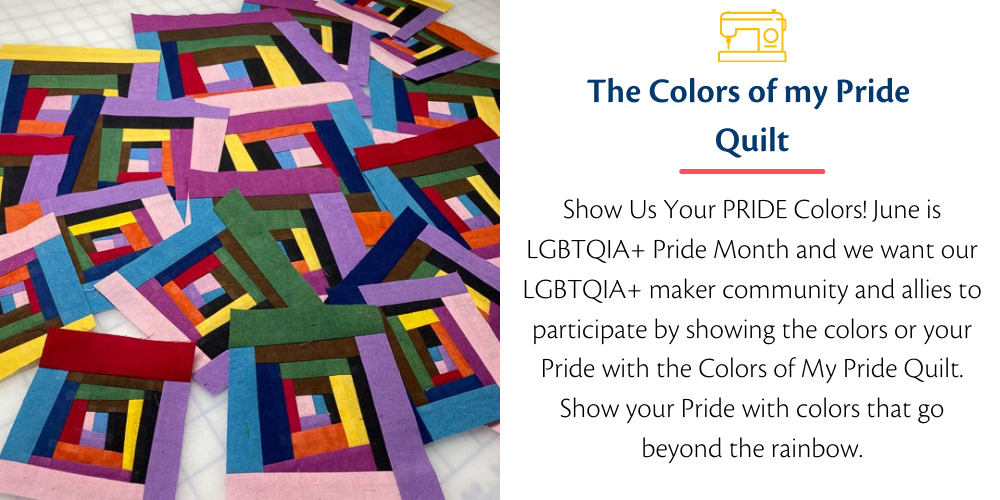
"Our quilt, The Colors of My Pride, is a combination of colors from across the wide range of vibrant Pride flags that we feel represents us best. The blocks themselves are created using a Scrappy Wonky Log Cabin block construction with 17 pieces built from the center out using a total of 11 colors repeated." - Jason & Shannon

Q&A with Shannon & Jason
1. What inspired you to create “The Colors of My Pride” quilt?
The seeds for Colors of My Pride quilt started growing a few years ago when we started making a conscious effort to do more with our fiber arts skills that represented us and our LGBTQIA+ and TGNCNB (Transgender, Gender Non-Conforming, Non-Binary) community. We started a few years ago with our They/Them Pullover crochet pattern, then we made a mini quilt of the Progressive Pride Flag. Both projects were very personal for us and helped us express more of who we are as LGBTQIA+ and non-binary people in the fiber arts community as a whole.
For years, we felt isolated and alone in the fiber arts community because most folx like us just didn’t feel comfortable expressing themselves publicly and companies were not encouraging us to produce projects for publication that in any way would upset the stereotypical, conservative-minded customers they believed they served. We decided we did not want new fiber artists coming up in the industry to have that same experience. We decided to put ourselves out there and be the LGBTQIA+ and TGNCNB representation we did not have when we first started in the industry.
Back to that mini quilt project we created for Pride last year, there were definitely leftover fabric scraps from the fat quarters we used to create it and we started playing with different quilt designs that would use those same Pride colors and expand on our creativity. There are actually a total of three Pride quilts that we designed but this one using a scrappy wonky log cabin construction is the one that we quickly became obsessed with. Anyone who has been to our classes or even our book Boro & Sashiko: Harmonious Imperfection knows we have a love for scrappy blocks and using fabric to create new and interesting textiles. That’s a long way of saying we love us some scraps of fabric! So… yeah… that’s how the Colors of My Pride quilt was born. It was the perfect collision of our creative brains and our love for our community.
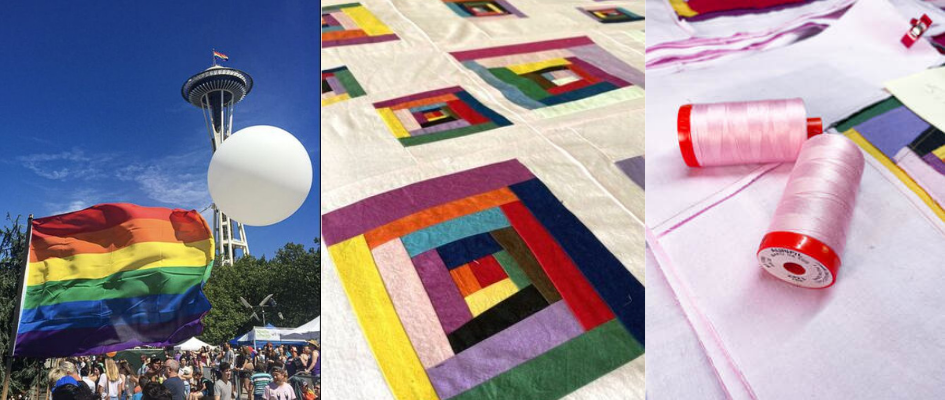
2. Each color used in the quilt blocks is unique and does not necessarily represent one flag from the LGBTQIA+ community, can you share more about that creative decision?
As fiber artists, color plays a major role in our lives… that probably goes without saying. But the way colors are assembled within the LGBTQIA+ and TGNCNB community to represent each of us and unite each of us, is even more important. The history of the banners we wave to represent us in the LGBTQIA+ and TGNCNB community is as deep and as colorful as the members of our community itself. Without writing a tome on the subject, we did delve into the specific colors WE chose on our blog post and, further, into the colors of some of the other Pride Flags.
Our colors in the Colors of My Pride quilt were a very personal choice. We picked colors from flags that hold significance in our hearts. Six of our colors came from the Rainbow Pride Flag that was originally designed by Gilbert Baker in 1977 at the behest of Harvey Milk (there’s a couple of community icons for you!). This is the flag that we grew up under in the LGBTQIA+ community. We also included the two additional colors from the More Color, More Pride flag created by Amber Hikes in 2017.
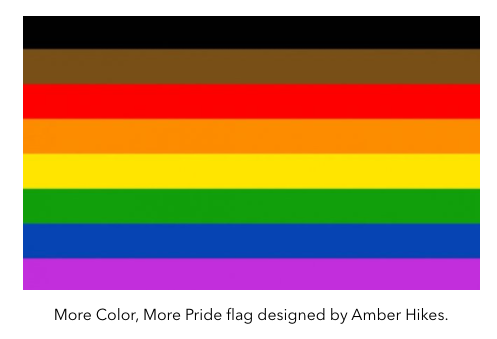
She created that flag as a way to, in her own words, “uplift the voices and experiences of LGBTQ people of color.” We can not represent our Pride without remembering and speaking out about the contributions of people of color in our community. From the first brick thrown at the Stonewall riots by black, transgender women and sex workers, to the ongoing contributions of LGBTQIA+ people of color, we would not be where we are without them.
We also drew inspiration from the Progressive Pride Flag created by Daniel Quasar in 2018. Quasar created a flag that included all of the previously mentioned colors as well as the colors of the Transgender Pride Flag.
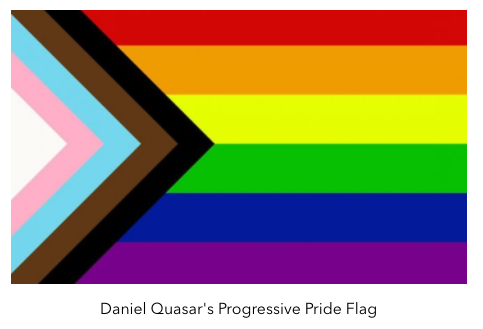
For our final colors, we used the pink and blue from the Transgender Pride Flag but also include lavender as a representation of the non-binary community that Shannon is part of. In all, we have eleven colors in our blocks that represent colors that hold the greatest significance to us. We hope that everyone will take a minute to read our post and decide for themselves which colors to include in their Colors of My Pride quilt.
3. Some members of the LGBTQIA+ community might be new to quilting but eager to get involved in this course! Any advice for quilting beginners?
First of all, we hope that all makers will join in! Yes, this is a fantastic way for the LGBTQIA+ and TGNCNB community to express the colors that represent their Pride, but it is also a way for folx outside of our community to share their support and love for friends, family, and the community at large.
Our main advice for folx who have not made a quilt project before is to start small and work your way up from there. Don’t put yourself under the pressure of making a king-sized quilt your first time out of the gate. And the Colors of My Pride quilt is the perfect project for first-time quilters keeping just that in mind. In the class, we will be creating a four-block sampler that will teach the skills for making the scrappy wonky style blocks from the pattern as well as the framing and finishing. For folx who have never picked up fabric and needle with thoughts of making a quilt before, this technique is forgiving and allows makers to have fun with the construction without worrying about perfectly matched corners and seams. Once we do get into the framing and finishing, we will walk folx through the process step by step so they can clearly see what comes next and execute each step before they move on. That’s the HUGE benefit of these techniques as well as the fact that the class is recorded. We’re teaching the class live but it will be recorded and folx will have access to it for one year! Even if they can’t make it to the live class, they can purchase the recorded version and have it to watch, rewind, learn from, and work on their blocks at their own pace on their own schedule. No pressure to finish in class, and no pressure to perform in front of other students. Oh… and, of course, folx who purchase the recording still have access to us on the Creative Spark platform so they can ask questions and share their progress with us.
4. What do you hope quilters walk away with after taking this course?
We hope they will have a lot of fun and have a FAB representation of the colors of their own Pride. Like us, most makers spend their creation time thinking about what they are doing and the exact steps they are taking in the process. We hope, in addition to an exciting process, folx will think about Pride and the rich history of our community. We hope LGBTQIA+ makers and those who join us from outside the community think about the colors they are choosing and why they choose them. Even if they never make another block, we hope this brings some awareness to LGBTQIA+ makers in our community and gives them a sense of pride that a pattern and class like this are out there in the world and that is supported by companies like Creative Spark and C&T Publishing, Aurifil thread, and Cherrywood Hand Dyed Fabric. We can stand up and be represented and we can do it without fear of being whisked off to the back corners of the industry. We can be here loud and proud and represent the colors of our Pride.
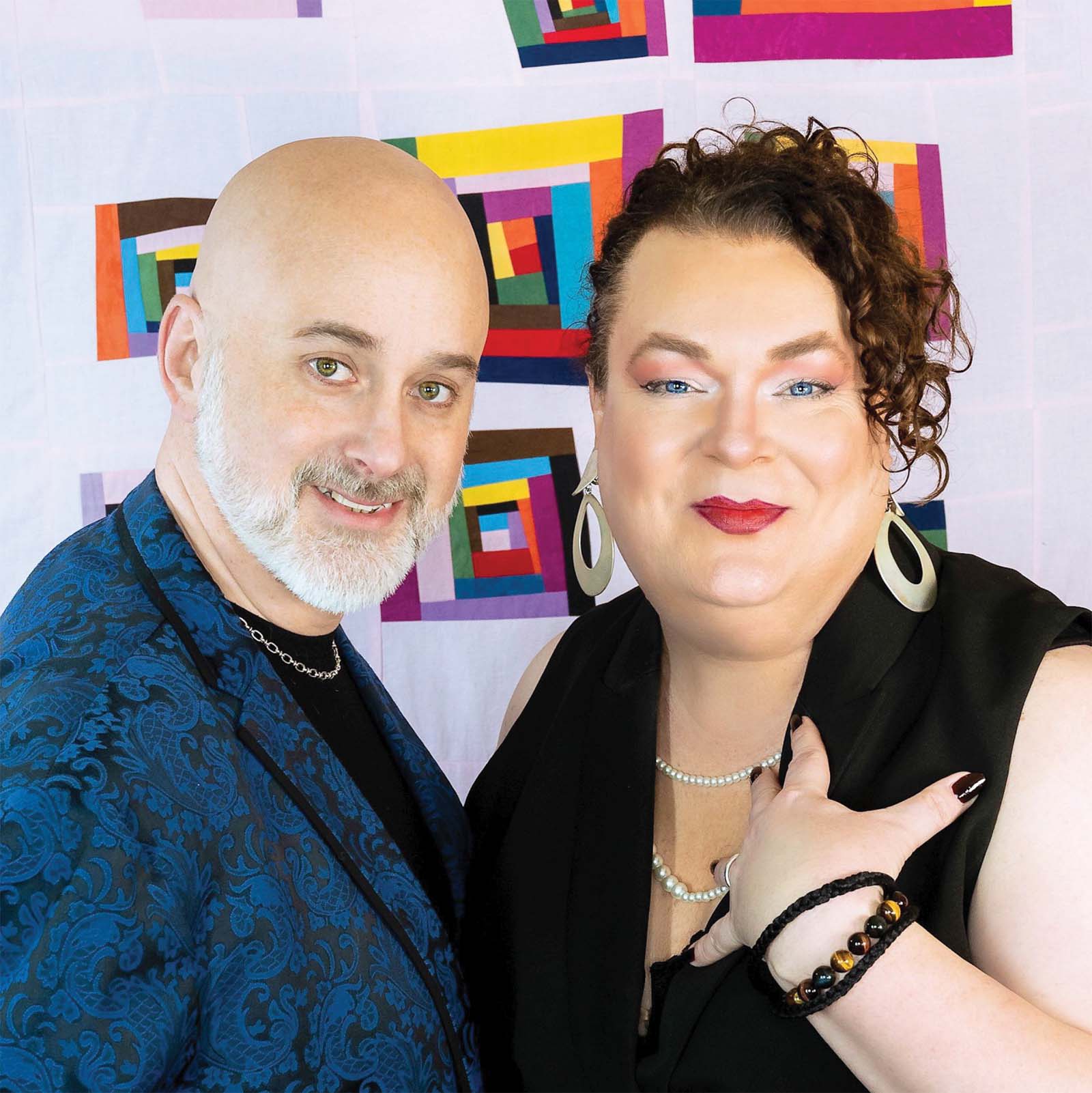
5. What are some of the important issues facing the LGBTQIA+ community today that you are passionate about?
We have both participated in activism in the LGBTQIA+ community since we first left our small towns right out of high school. We didn’t meet until 27 years ago but we started those journeys of speaking out for our own rights as soon as we were among other folx like us. While the LGBTQIA+ community has made great strides, we are still fighting for basic rights like housing security, job security, and access to healthcare. There are places in the United States where we can be fired, evicted, denied jobs, denied loans, and turned away from healthcare just because of who we were born as. It wasn’t until 2012 that the two of us were able to be legally married in Washington State. The struggle for basic rights in our community is real and we have a lot of work to do.
That said, at the time of this interview, there are over one hundred pieces of legislation being passed at the state level that deny transgender folx the right to basic healthcare and gender affirming treatments. These are being driven by a coalition of conservative politicians and business people who are shoveling money and propaganda into the process to ensure these hateful, dangerous laws are passed. Some laws even make it a felony for doctors to give gender affirming care to any LGBTQIA+ person and parents who are doing what is right for their trans kids are in danger of being charged with a felony and having their children taken away. It is enraging to see these folx stand on a platform of hate and have their voices boosted by millions of dollars from corporations. You can read more about this and listen to this special report by Chase Strangio, one of the lawyers for the ACLU that is a hero battling on the front lines to protect trans youth and the LGBTQIA+ community. That report is here: https://www.aclu.org/news/lgbtq-rights/special-report-chase-strangio-on-the-legislative-assault-on-trans-youth/
Another issue that can not be ignored is the murder rate of TGNCNB people. In 2020, there were a total of 44 confirmed fatalities from murder making 2020 the deadliest year since these crimes were tracked starting in 2013. To our horror, we have already seen 28 transgender people murdered this year already. The majority of those victims are black transgender women. Unless more is done to protect our TGNCNB community; unless more education is made available; unless more funding goes into education and informing the public about the truths of our community rather than the lies spread by our former administration and their current followers, the deaths will continue to rise. The ACLU is a great resource for action and education but the National Center for Transgender Equality does amazing work and has specific action items and resources available on their website here: https://transequality.org/
Again, there are many issues that affect our community as a whole and those issues that affect each of us individually. The best advice we can give to folx who want to learn more and take action is to start with one cause that speaks to you or hits home to you or to someone you love. If you can’t actively participate, join petition drives and donate money. If you can’t do that, post education on your social media. And each of us has a powerful tool at our disposal: our crafts. Whether you make a project created by an LGBTQIA+ or TGNCNB designer or you buy products from our community, you are showing us you support us and lending your voice to the cause. Any step is a step in the right direction. As with our advice about quilting, start small and go from there.
-
Learn more on the Shannon & Jason's blog







